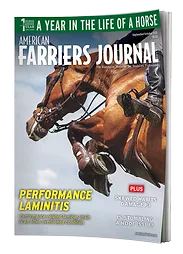Biotin has proven to aid the proper development of healthy hooves. Studies have concluded that adding 10 to 40 milligram of biotin per day, depending on weight, results in improved hoof hardness, integrity and conformation.
Biotin has proven to have a direct effect on the epidermis associated with hoof horn formation and quality. Biotin is required as a micronutrient and is rate limiting in the process of removing fatty acids from the liver. Through the elimination of a fatty liver, the horse can properly metabolize nutrients and supply the hoof with proper amino acids and minerals for healthy growth.
DL Methionine, an essential amino acid, is required for proper hoof protein development. DL Methionine is a sulfur-bearing amino acid. Research has shown that sulfur-bearing amino acids play an important role in the proteins of the equine hoof wall.
The Role Of Vitamins
Vitamin A is important for the hoof, as it plays a role in the formation and protection of epithelial tissue which comprises the bulk of the hoof wall. Vitamin A is thought to do this through participating in the synthesis of glycoproteins which control both cell differentiation and gene expression.
Vitamin D3 aids in the control of calcium homeostasis, helps coordinate phosphate metabolism and participates in the regulation of bone growth and metabolism. Vitamin D3 is metabolized through exposure to sunlight. However, if horses are not receiving adequate sunlight, supplementation is important for the proper metabolism of both calcium and phosphorus, which are needed for proper hoof development.
Vitamin E and selenium work synergistically as antioxidants to protect molecules that are vulnerable to oxidation. Selenium works as a part of the intracellular enzyme, glutathione peroxidase, which helps prevent free radicals from causing damage to tissues. Vitamin E blocks free radicals from attacking lipids and forming lipid peroxides.
Protecting The Liver
Choline and inositol, are B vitamins which act as lipotropic agents, aiding in the prevention of fat accumulation in the liver. Like biotin, choline plays a rate-limiting role in the removal of fatty acids. If choline is deficient, a fatty liver can result, leaving the horse with higher concentrations of triglycerides in the liver and a reduction in the release of lipoproteins into the blood. Instol helps to properly utilize choline and promotes healthy hair, hoof, and bone.
Niacin is important for metabolic processes to insure healthy skin as well as proper function of the digestive tract. Like other B vitamins, niacin is produced in the horse’s gastrointestinal tract by microbes. Niacin is produced by the body from the amino acid, tryptophan, however, many cereal grains contain high levels of leucine which interfere with the conversion of niacin from tryptophan.
Zinc And Copper
Zinc is important in tissues including skin, liver, bone and muscle. When a zinc deficiency persists, the horse may suffer hair loss, lethargy, diarrhea, decreased feed intake, as well as decreased growth rate. Zinc deficiency along with copper deficiency, has been associated with metabolic bone disorders in foals, such as osteochondrosis, epophysitis and contracted tendons. Copper is needed for bone, cartilage, elastin formation, utilization of iron, and it improves pigmentation and the structure of hair and hoof.
Iodine is most commonly associated with enlargement of the thyroid gland, known as goiter. The condition can be either a result of excess iodine in the diet or an iodine deficiency. This makes many fear using iodine. However, iodine toxicity is unlikely to occur under normal feeding conditions. The National Research Council estimates iodine is safe at levels up to 5 mg/kg of dry matter intake per day. Common equine feeds range from 0 to 2 mg/kg of iodine. Levels vary depending on iodine content in the soil.
Iodine And Foot Health
Iodine is necessary for many biological processes. It is utilized by the thyroid in the production of hormones which aid in regulating the horse’s basal metabolic rate as well as affecting intracellular processes of oxidation. Ethylenediamine dihydriodide (EDDI), a source of iodine, has been supplemented in the diet of cattle to prevent foot rot. Studies in the late ’70s and early ’80s were conducted with cattle to test whether orally administered EDDI would aid in the prevention and treatment of hoof rot. EDDI was found to be effective as a nutritional therapy for this purpose.
Field studies have indicated the use of supplements containing controlled amounts of iodine are effective in the treatment and prevention of white line disease.






